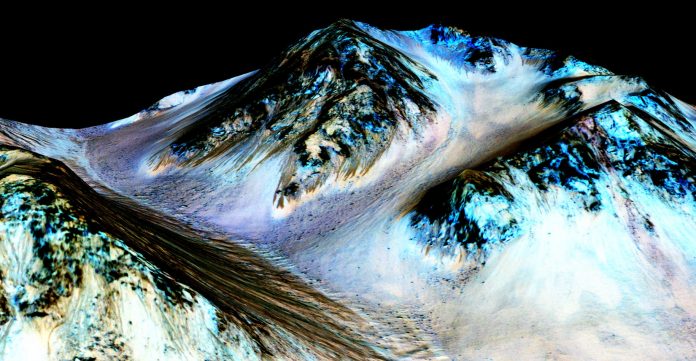
Researchers using the Mars Reconnaissance Orbiter found an ice deposit hidden beneath the surface of Mars, a report published by NASA’s Jet Propulsion Laboratory at the California Institute of Technology (CalTech) revealed yesterday.
The cutting-edge ground-penetrating Shallow Radar (SHARAD) detected the layer within the proximities of Mars’ Utopia Planitia region, located at the planet’s mid-northern latitudes. Scientists estimated the deposit’s size at about 260 to 560 feet (80 to 170 meters) thick.
The layer’s composition is about 50% to 80% water in its solid state, the rest being a combination of dust and rock particles. This finding is one of the most significant attained from research on the Red Planet since its exploration began in the 1960s.

Martian water changes the prospects of space exploration entirely. New doors are now open
This layer of ice could change the future of Martian exploration as we know it. Along with ongoing projects such as Tesla’s project X new fuel testing for a Mars colonization spacecraft, this deposit could stand as the first survival resource for future manned missions to the Red Planet.
Water on Mars entirely shifts the prospects expected for first human colonies on the planet’s surface, and also renews hope for advancements in exploration after the recent failure of the European Space Agency’s Schiaparelli mission.
The amount of water in this current ice layer rivals that of Lake Superior, shared among Canada’s Ontario region and the states of Minnesota, Wisconsin, and Michigan, which currently holds about 12,000 cubic kilometers of water. Researchers estimate that this deposit represents less than one percent of Mars’ water reserves.

The ‘Utopia deposit’ sits about up to 33 feet below the ground
Photos of the Martian surface showed scalloped depressions that prompted researchers to check for ice deposits, undergoing more than 600 overhead SHARAD passes. The data retrieved for this scouting revealed the layer’s area, confirmed to be bigger than the state of New Mexico.
The ice keeps its solid state because it’s hidden underground at the depth mentioned above. Mars’ closeness to the Sun makes it impossible for water to exist naturally anywhere closer to the its surface, where it instantly becomes vapor.
Geophysicist Cassie Stuurman indicated that the deposit probably formed at a period in Martian history in which the planet’s axis was more tilted, allowing for weather conditions such as now to occur. She’s the lead author on a separate study on the subject and recently shared her team’s findings via Twitter.
My post explaining my Utopia paper has been featured on @exploreplanets blog! Check it out for a tl;dr of the paperhttps://t.co/mJeg32rKFf
— Cassie Stuurman (@corginaut) November 22, 2016
What we currently know about Water on Mars and what we need to find out
Initially, Mars had a volume of water on its surface that contributed to the formation of rivers and lakes. Most of the liquid evaporated to form the planet’s thin atmosphere, as orbital changes brought it closer to the Sun.
The importance of Mars’ water exploration and also of its underground deposits not only could help future human settlements but also current scientific research on weather and geological conditions.
Scientists currently conduct research on Martian soil by comparing photographed landforms to some found on the surface of the Canadian Arctic region, which helped find underground ice settlements below the Earth’s surface in the past.
Source: NASA Jet Propulsion Laboratory











